A novel CpG-methylation-based nomogram predicts survival in colorectal cancer
- PMID: 32396412
- PMCID: PMC7595584
- DOI: 10.1080/15592294.2020.1762368
A novel CpG-methylation-based nomogram predicts survival in colorectal cancer
Abstract
Aberrant DNA methylation is significantly associated with the prognosis of patients with colorectal cancer (CRC). Therefore, the aim of this study was to develop a CpG-methylation-based nomogram for prognostic prediction in CRC. First, 378 CRC patients with methylation data from The Cancer Genome Atlas were randomly divided into training cohort (n = 249) and test cohort (n = 129). A multistep screening strategy was performed to identify six CpG sites that were significantly associated with overall survival in the training cohort. Then, Cox regression modelling was performed to construct a prognostic signature based on the candidate CpG sites. The six-CpG signature successfully separated patients into high-risk and low-risk groups in both training and test cohorts, and its performance was superior to that of previously published methylation markers (P < 0.05). Furthermore, we established a prognostic nomogram incorporating this signature, TNM stage, and age. The nomogram exhibited better prediction for overall survival in comparison with the three independent prognostic factors in the training cohort (C-index: 0.798 vs 0.620 to 0.737; P < 0.001). In the test cohort, the performance of nomogram was also superior to that of the three independent prognostic factors (C-index: 0.715 vs 0.590 to 0.665; P < 0.05). Meanwhile, the calibration curves for survival probability showed good agreement between prediction by nomogram and actual observation in both training and test cohorts. Together, the present study provides a novel CpG-methylation-based nomogram as a promising predictor for overall survival of CRC patients, which may help improve decision-making regarding the personalized treatments of patients with CRC.
Keywords: DNA methylation; colorectal cancer; nomogram; prognosis; survival analysis.
Conflict of interest statement
No potential conflict of interest was reported by the authors.
Figures
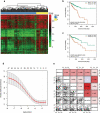
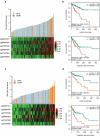
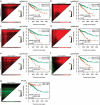
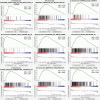

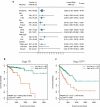
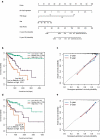

Similar articles
-
Development and validation of 3-CpG methylation prognostic signature based on different survival indicators for colorectal cancer.Mol Carcinog. 2021 Jun;60(6):403-412. doi: 10.1002/mc.23300. Epub 2021 Apr 7. Mol Carcinog. 2021. PMID: 33826760
-
A methylation-based nomogram for predicting survival in patients with lung adenocarcinoma.BMC Cancer. 2021 Jul 12;21(1):801. doi: 10.1186/s12885-021-08539-4. BMC Cancer. 2021. PMID: 34247575 Free PMC article.
-
Prognostic nomogram to predict the overall survival of patients with early-onset colorectal cancer: a population-based analysis.Int J Colorectal Dis. 2021 Sep;36(9):1981-1993. doi: 10.1007/s00384-021-03992-w. Epub 2021 Jul 29. Int J Colorectal Dis. 2021. PMID: 34322745 Free PMC article. Clinical Trial.
-
Prognostic DNA methylation markers for sporadic colorectal cancer: a systematic review.Clin Epigenetics. 2018 Mar 14;10:35. doi: 10.1186/s13148-018-0461-8. eCollection 2018. Clin Epigenetics. 2018. PMID: 29564023 Free PMC article.
-
Computational Analysis of High-Dimensional DNA Methylation Data for Cancer Prognosis.J Comput Biol. 2022 Aug;29(8):769-781. doi: 10.1089/cmb.2022.0002. Epub 2022 Jun 6. J Comput Biol. 2022. PMID: 35671506 Free PMC article. Review.
Cited by
-
Development and Validation of the Individualized Prognostic Nomograms in Patients With Right- and Left-Sided Colon Cancer.Front Oncol. 2021 Nov 1;11:709835. doi: 10.3389/fonc.2021.709835. eCollection 2021. Front Oncol. 2021. PMID: 34790565 Free PMC article.
-
Hypermethylation of tumor suppressor lncRNA MEF2C-AS1 frequently happened in patients at all stages of colorectal carcinogenesis.Clin Epigenetics. 2022 Sep 5;14(1):111. doi: 10.1186/s13148-022-01328-1. Clin Epigenetics. 2022. PMID: 36064442 Free PMC article.
-
Identification of Hub Gene TIMP1 and Relative ceRNAs Regulatory Network in Colorectal Cancer.Ther Clin Risk Manag. 2021 Aug 27;17:889-901. doi: 10.2147/TCRM.S321101. eCollection 2021. Ther Clin Risk Manag. 2021. PMID: 34475758 Free PMC article.
-
Single Nucleotide Polymorphisms in the Vitamin D Metabolic Pathway as Survival Biomarkers in Colorectal Cancer.Cancers (Basel). 2023 Aug 12;15(16):4077. doi: 10.3390/cancers15164077. Cancers (Basel). 2023. PMID: 37627104 Free PMC article.
-
Novel pretreatment nomograms based on pan-immune-inflammation value for predicting clinical outcome in patients with head and neck squamous cell carcinoma.Front Oncol. 2024 Jun 10;14:1399047. doi: 10.3389/fonc.2024.1399047. eCollection 2024. Front Oncol. 2024. PMID: 38915366 Free PMC article.
References
-
- Bray F, Ferlay J, Soerjomataram I, et al. Global cancer statistics 2018: GLOBOCAN estimates of incidence and mortality worldwide for 36 cancers in 185 countries. CA Cancer J Clin. 2018. November;68(6):394–424. . - PubMed
-
- Guraya SY, Pattern S.. Time of recurrent colorectal cancer after curative surgery. Clin Colorectal Cancer. 2019. June;18(2):e223–e228. - PubMed
-
- Weisenberger DJ, Siegmund KD, Campan M, et al. CpG island methylator phenotype underlies sporadic microsatellite instability and is tightly associated with BRAF mutation in colorectal cancer. Nat Genet. 2006. July;38(7):787–793. . - PubMed
Publication types
MeSH terms
Substances
LinkOut - more resources
Full Text Sources
Other Literature Sources
Medical
